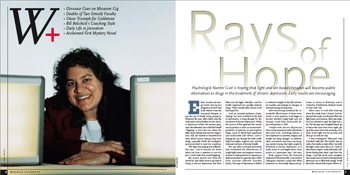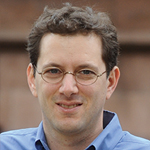Rays of Hope
 Ellen’s moods and energy levels during her pregnancy weren’t bad at all. Maybe it was the hormonal changes, or just the joy of finally being pregnant. Whatever the case, Ellen didn’t miss the medication she had taken for her chronic depression before she became pregnant. But afterward, she could feel herself “slipping,” a term she uses when she talks about sliding back into her depression. Still, she wanted to breastfeed her baby, which meant staying away from drugs, especially Zoloft, the antidepressant prescribed to treat her condition.
Ellen’s moods and energy levels during her pregnancy weren’t bad at all. Maybe it was the hormonal changes, or just the joy of finally being pregnant. Whatever the case, Ellen didn’t miss the medication she had taken for her chronic depression before she became pregnant. But afterward, she could feel herself “slipping,” a term she uses when she talks about sliding back into her depression. Still, she wanted to breastfeed her baby, which meant staying away from drugs, especially Zoloft, the antidepressant prescribed to treat her condition.
“The days were getting very difficult,” she says. “You’re already run down when you have a newborn to care for, but I could really feel myself slipping.”
She wasn’t exactly sure what she would do. She didn’t want to go back to living in chronic depression. But then Ellen saw the light—literally—and her health improved very quickly, without drugs. That’s exactly what Namni Goel had hoped for.
Goel, an assistant professor of psychology, has been troubled by the lack of alternatives to drug therapy for the treatment of chronic depression. While the success of this approach has varied, one by-product is clear: an increased dependency of patients on prescription drugs, many of which have significant and undesirable side effects. Goel is hoping she can change this with a little help from lights, negative ions, and the National Institute of Mental Health.
She and other scientists previously had established the effectiveness of bright light boxes and negative ionizers (similar to high-powered air cleaners) as daily treatments for patients who suffer from Seasonal Affective Disorder (SAD). This type of depression is linked to reduced sunlight in the fall and winter months and perhaps to changes in internal timing mechanisms.
After witnessing firsthand the remarkable effectiveness of these treatments in SAD patients, Goel began to wonder whether bright light and ion therapy could help chronically depressed patients as well.
“People with chronic depression share many symptoms with individuals who have SAD, including sadness, a loss of pleasure in activities, fatigue, and weight and sleep changes. In addition, other researchers had some encouraging results hinting that light might be beneficial in chronic depression, so it made sense to investigate these treatments in a systematic way,” she says.
With support from the National Institute of Mental Health, Goel and her colleagues initiated a study that offers treatment to chronically depressed patients in clinics at Wesleyan and at Columbia Presbyterian Medical Center in New York City.
Ellen came to Goel after hearing about the study from a friend. Goel explained the study and showed Ellen the light boxes and ionizers. Ellen was skeptical but decided to give the light box a try. The therapy was straightforward: go to bed at the same time every night, get up at the same time each morning, sit in front of the light box for an hour and then go on with her day.
“I was so energized,” Ellen said. “And it worked really fast. The Zoloft I was on took a few weeks to take effect, but with the light, it was just a day or so. I had no idea what to expect. It was definitely a different feeling than what I got from the drugs. I just felt much more energetic than usual, and it’s hard to feel depressed when you are so filled with energy. To tell the truth I almost didn’t quite believe it.”
Ellen also tried a stint with the ionizer, which helped, but went back to the light box, which emits a full spectrum of light minus the ultraviolet band.
“I just liked what it did for me better,” she says. “I think part of this is finding what works for you.”
The results with other test subjects have been encouraging. More than half of the 20 participants reported a significant reduction in symptoms, many after just one or two weeks of the light or ion therapy—results comparable to or better than most drug studies. Both treatments were equally effective.
“I am hoping that these non-drug treatments will become a viable alternative to medication: they have fewer side effects, work more rapidly than drugs, and may be beneficial for people who don’t respond to drugs or relapse while on them. In addition, drug-induced side effects, which can include insomnia, weight gain, and decreased libido, among other things, can be quite debilitating and difficult to manage longterm. My goal is to make patients feel better quickly without these unwanted consequences.”
Perhaps the only negative Goel has uncovered so far is that, after the study ends, some patients cannot continue the therapy.
“To buy a light box is about $400, which I know isn’t a lot to some people, but it’s significant to my husband and me, especially with a new baby,” Ellen says. “We can’t afford one right now, and our insurance won’t pay for one, so I will probably be going back to the drugs again. I’ll need something.”
Goel’s ongoing outpatient depression study is just one component of her research. She also has a state-of-the-art sleep and circadian (24-hour or daily) rhythm laboratory located in Judd Hall. She is hoping to better explain the biological and psychological significance of environmental, non-drug stimuli’s effects on mood, sleep, and circadian rhythms.
“My interests have health-related significance to individuals with mood and sleep disorders, such as depression and insomnia,” she says, “and also have nonclinical applications to more commonlyexperienced situations such as jet lag and shift work. Ultimately, my research aims to develop safe, effective alternatives to popular pharmacologic treatments, such as antidepressants and sedative hypnotics, for such conditions.”



